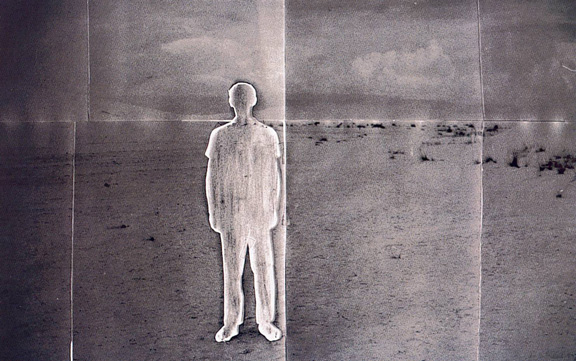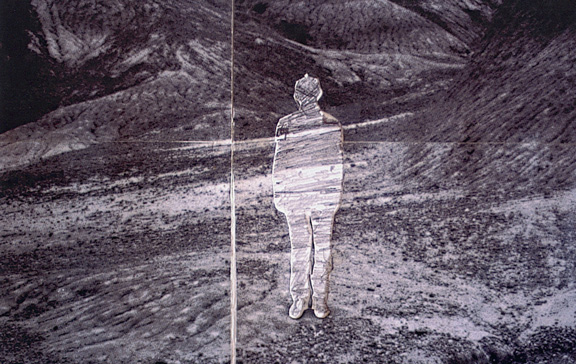Mala Gallery
8, Zamkowy Sq., Warsaw (Old Town)
4 - 30 October 2005
Kostas Kiritsis - REINCARNATIONS

Kostas Kiritsis - from series ""NON-APPEARANCE", exhibition at Mala Gallery in Warsaw, Poland, October 2005.
THE SERIES entitled Non-appearance emerged more or less coincidentally in the wake of Witness of the Revolution. When the artist had finished his series of self-portraits he was left with the remains of the images - the outline of his body.In Non-appe- arance these empty forms are inserted in landscape photographs taken in the USA, where the artist now lives. The result is almost disturbing - an apparently sublime natural romanticism broken by a ghostlike figure. This is emphasised by the title of the series: there is something here that never appears. The viewer cannot attribute the figure in the works individual, recognisable traits, and it remains impossible to determine which way the figure is facing. Is the figure looking at the landscape or facing us? Can viewers place themselves within the outline?
Kostas Kiritsis tells of the feeling he often had as a child after entering new territory and experiencing 'exotic' landscapes. Later he wondered whether the places he had visited were still there after he had left - or whether they only existed due to his experi- ence of them. The work can thus be seen as a visualisation of the basic, existential thoughts of the child - a personal memory and bodily experience.
Often when one takes photographs in new places - as a tou- rist for example - it is to prove 'I was here'. The photograph is a means of storing the scenery and occasion - a kind of memory prop. Consciousness has often been compared to a camera, but in Kostas Kiritsis' works it is the creation of memory that is central. .Here the photograph is not only retrospective - a receptacle for memories of the past - but also an event that actively generates reality. Realities are not given but created by the way we remem- ber them and the images we create of them, including photo- graphs. The work thus focuses on photographs as memories that go beyond reactionary nostalgia.
If seen as an exploration of the relationship between consci- ousness and the world the series can also be located in a pheno- menological philosophical context. Maurice Merleau-Ponty, for example, claimed human consciousness to be constantly embed- ded in the world operating at the level before separation and the establishment of a hierarchy between subject/object, inner/outer. Thus the act of seeing the world around us will reflect our gaze, and in this perspective the transparent template can be interpret- ed as the materialisation of the landscape looking back at us. Here it is not so much the appearance of the outline that disappears in the landscape, but rather the landscape that becomes visible via the outline. In other words, the surrounding world leaves imprints on our bodies, just as it leaves imprints on the light-sensitive mate- rial that constitutes a photograph via the camera.
The last series consists of reworked photographs of the heads of classical sculptures. The backgrounds have been painted silver, transforming the heads from arbitrary stone fragments into exalted portraits. The heads are rendered even more lifelike by the additi- on of photographs of real eyes - Kostas Kiritsis' own eyes. The pho- tographs are taken from different angles, making them dynamic and lifelike, as if the figure has turned its head. The painted metal- lic background emphasises the warm glow of the 'skin'. Numerous photography theorists - including Roland Barthes - have analysed the embalming effect of photography: that the act of being photo- graphed is a form of death, freezing the subject forever in a past moment. But in Kostas Kiritsis' work the photographs or rather montages possess the power to resurrect. The sculptural fragment, rooted in Greek culture like the artist himself, is thus brought into the present. Kiritsis performs what can be seen as an active ana- chronistic art history. The analysis of past - also in the realm of art - is always dependent on the historian's own time. An openness to the potential tor change in (art) history thus remains essential.
In all three series the artist works with different forms of self- portrait and refers to different ways of writing history. Both the medium of photography and the montage technique are central. The philosopher Walter Benjamin also transferred the montage principal to his ideal of history as large constructs joined by smal- ler components relevant and meaningful to us in the present. A small, individual moment thus holds the potential for the crystalli- sation of an overall view. In his montages Kostas Kiritsis introduces an anachronism that traverses the boundaries of traditional histori- ography - a pendant to Benjamin's demand to reinterpret the memories that are passed from epoch to epoch rather than sim- ply accepting the 'official' version. Benjamin also repeatedly des- cribed historical methodology with photographic analogies, as in his recurrent concept of 'the dialectical image': a sudden flash of appearance capable of bringing the previously disregarded into view. The past becomes instantly readable and communicates with the future. The unique Self-portraits can also awaken the dormant links between the past and the present bringing them to life for us today.
Louise Wolthers
Translation: Jane Rowley.
A fragment of text from a catalogue of the exhibition „Kostas Kiritsis, Self Portraits”, Galleri Image, Arhus, Denmark, 28.05-26.06.2005.
ISBN 87 990829-1-8

Kostas Kiritsis - from series ""NON-APPEARANCE", exhibition at Mala Gallery in Warsaw, Poland, October 2005.
BREAKING the photography. These two words describe well the work of Kostas Kiritsis.
Kostas Kiritsis already in his first installation "The Book" presented almost 10 years ago in the Mala Gallery adscribed to his photographs function of creating an atmosphere rather than that of reporting on the perceived world. Similarly, it was also the case of his other series, e.g. "Lesson of the fast landscape". In spite of that these photographs were taken in definite places (e.g. Gobi Desert) they always referred to sensual perception of reality. The more important role in these pictures was played by elusive atmosphere of nostalgy evoked by distant journeys rather than by tangible concreteness of recorded people and things.
In "Reincarnations" Kiritsis returns to his childhood. By inserting outline of his own body into spaces he is revisiting he tries to reconstruct the way he felt then the important for him landscapes that stayed permanently in his memory. This is very simple, symbolic and innocent operation that makes us to ponder upon transitoriness that is so closely related to photographic medium.
Marek Grygiel
Warsaw 29 IX 2005.
Earlier in FOTOTAPETA:
In FOTOTAPETA also:
Copyright © 1997-2025 Marek Grygiel / Copyright for www edition © 1997-2025 Zeta-Media Inc.